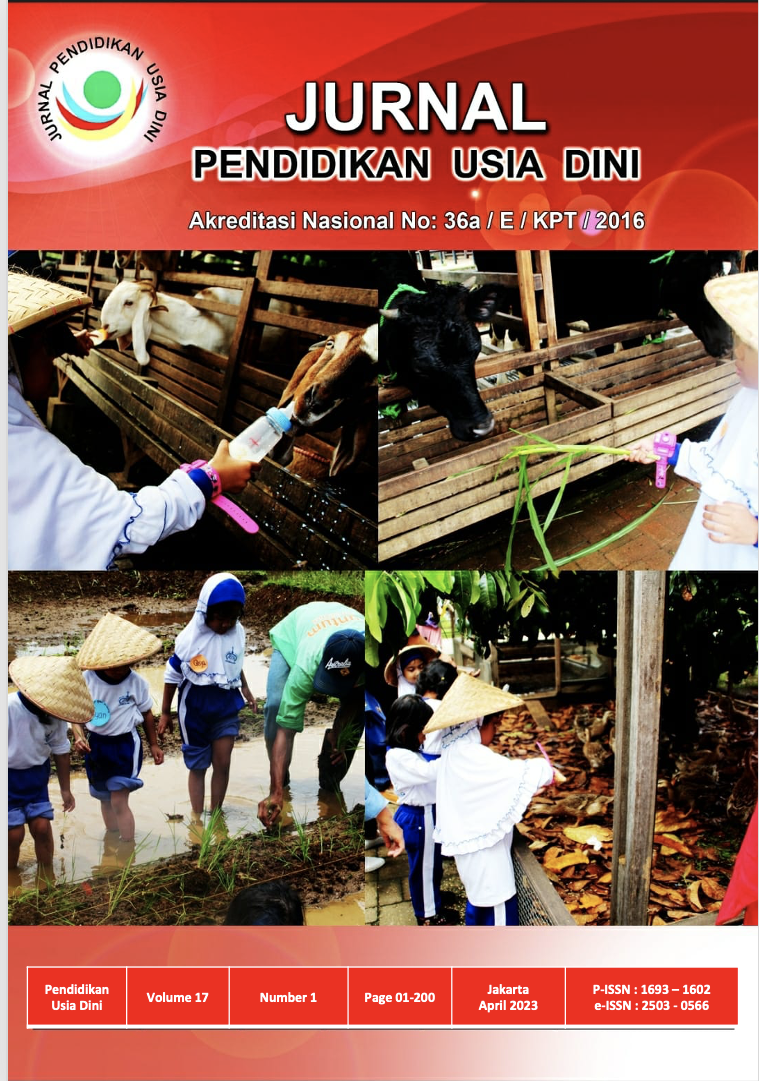Development of Zapin's Creative Dance to Improve Children's Kinesthetic Intelligence Aged 5-6 Years
DOI:
https://doi.org/10.21009/JPUD.171.13Abstract
The purpose of this study was to develop dance-based learning media created by Zapin to improve the kinesthetic intelligence of children aged 5-6 years. This study is motivated by the low level of kinesthetic intelligence in children aged 5-6 years because the learning activities carried out by the teacher do not attract children's interest, causing low kinesthetic intelligence in children. In developing creative dance movement learning media using the development stage based on the ADDIE model (Analyze, Design, Development, Implementation, and Evaluation). The feasibility test was carried out by 2 validators, namely dance experts and ECE experts. The test subjects in this study were children aged 5-6 years in Tanggamus Regency, which consisted of 20 children. Data collection was carried out using interviews, observation, questionnaires, and documentation. The media effectiveness test was carried out using the one-group pretest-posttest method. From the results of the effectiveness test, it can be concluded that the developed creative dance can improve kinesthetic intelligence in children aged 5-6 years which consists of aspects of whole-body coordination, balance, agility, and flexibility in children who have carried out learning to move creative dance using the developed media.
Keywords: kinesthetic intelligence, dance movement creations, early childhood
References:
Anggraini, D. D., Dhiba, S. A. F., & Ittar, A. (2016). Improvement of Gross Motor Skills Through Animal Dance Activities in Children Group B. Journal PG-PAUD Trunojoyo, 3(2), 128–137.
Anisa, S. (2014). Learning Dance and Song Movement Using Demonstration Methods In Kindergarten Kartika II-31. Journal of Education, 31.
Brown, A. K. (2014). A Model for Dance Education: Promoting Personal Voice and Communal Learning. International Journal of Education Through Art, 2(10).
Dewi, W. R. (2018). Implementation of Dance Creation in Developing Children's Kinesthetic Intelligence in Paud Negeri Pembina 1 Bengkulu City.
Diana, F. (2013). Application of Singing Methods Using Learning Aids to Improve Children's Kinesthetic Intelligence In Group B2 of Aisyiyah Kindergarten Ii Manna Market of South Bengkulu Regency.
Gardner, H. (2006). Changing Minds. United State of America: Massachusetts Hardvard Business School Press.
Jamaris, M. (2015). New Orientation in Educational Psychology. Bogor: Ghalia Indonesia.
Jamaris, M. (2017). Measurement of Plural Intelligence. Bogor: Ghalia Indonesia.
Junaedi, S., & Nugroho, I. H. (2014). Traditional Game Fortan as a Method of Play for the Development of Early Childhood Kinesthetic Intelligence. Nusantara Of Research, 38–44.
Majidah, S. K., Khadijah, & Sapri. (2018). Efforts to Increase Early Childhood Kinesthetic Intelligence Through Dancing Activities in Group B in Ra Al-Ikhlas Medan. Journal of RAUDHAH, 6(2), 2338–2163.
Mulyani, N. (2016). Early Childhood Dance Arts Education. Yogyakarta: Gava Media.
Mulyasa. (2014). Manajemen PAUD. Bandung: PT Remaja Rosdakarya.
Muntiah, D. (2010). Psikologi Bermain Anak Usia Dini. Jakarta: Kencana.
Myrnawati C.H. (2018). Metodologi Penelitian Untuk Pemula. Tanggerang Selatan: Pustakapedia
Nurani, Y. (2019). Perspektif Baru Konsep Dasar Pendidikan Anak Usia Dini. Jakarta: Cam Pustaka.
Nurani, Y. (2020). Kurikulum Bermain Kreatif Berbasis Kecerdasan Jamak. (Y. Nurani, Ed.) (III). Jakarta: PT Indeks.
Papalia, D. E., & Dkk. (2018). Human Development (Developmental Psychology) Jakarta. Retrieved from Kencana
Rouf, A.M. (2018). Improves Children's Gross Motor Development Through the Manuk Dadali Dance Method. Bunda Window Journal, 6(1), 30–37.
Sansom, A. N. (2016). Finding Dance in Sylvia s Classroom. Waikato Journal of Education, 1173–6135. https://doi.org/10.15663/wje.v14i1.215
Special, I. (2016). Increase Children's Kinesthetic Intelligence Through Traditional Dance Nods at Melati II Glagah Kindergarten. Journal of Early Childhood Education, 3, 292–300.
Sumarni. (2014). Improving Children's Kinesthetic Intelligence Skills Through Group B Hide and Seek Games.
Suyadi. (2015). Basic Concept of PAUD. Bandung: PT Remaja Rosdakarya.
Warburton, E. C., Reedy, P., & Ng, N. (2014). Engaging Families in Dance: An Investigation of Moving Parents and Children Together. International Journal of Education & the Arts, 15.
Wira, P. (2018). Peningkatan Kreativitas Melalui Bermain Tari Kreasi Berbasis Multimedia. Jurnal Pendidikan Anak, 7(2), 106–121.
Wulandari, R. T. (2017). Pembelajaran Olah Gerak Dan Tari Sebagai Sarana Ekspresi Dan Apresiasi Seni Bagi Anak Usia Dini. Jurnal Pendidikan, 147–162.
Yaumi, M. (2012). Learning is based on multiple intelligences. Jakarta: Dian Rakyat.
Yetti, E. (2012). The Influence of Learning Models and Dance Movement Skills on Early Childhood Emotional Intelligence. Journal of Arts & Stage Culture, 22(2), 213–224. Dewi, W. R. (2018). Implementation of Dance Creation in Developing Children's Kinesthetic Intelligence in Paud Negeri Pembina 1 Bengkulu City.
Yetti, E., & Juniasih, I. (2016). Implementation of Educational Dance Learning Model to Improve Early Childhood Kinesthetic Intelligence Through Active Learning Methods (Development model in Labschool Jakarta Kindergarten in Group B). Journal of Early Childhood Education, 10(9), 385–400.
Downloads
Published
How to Cite
Issue
Section
License
JURNAL PENDIDIKAN USIA DINI work is licensed under a Creative Commons Attribution 4.0 International License. (http://creativecommons.org/licenses/by/4.0/)





